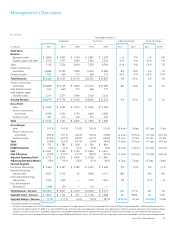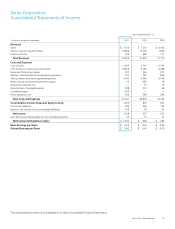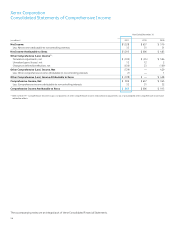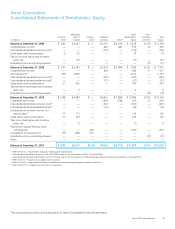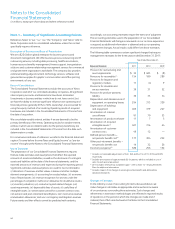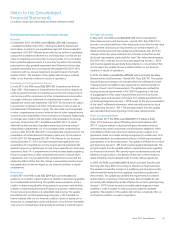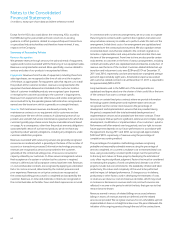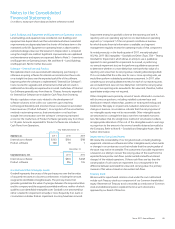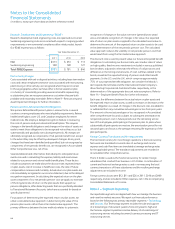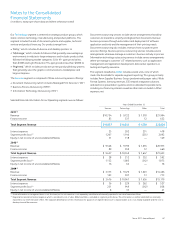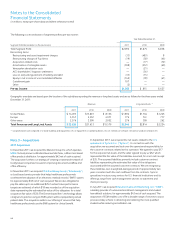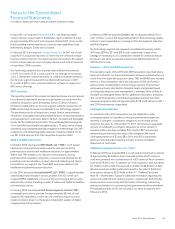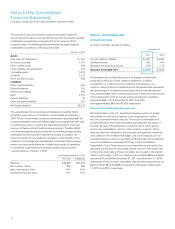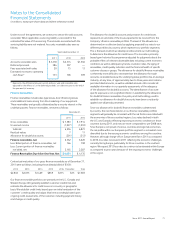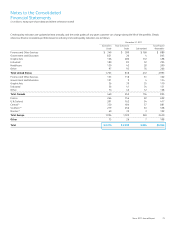Xerox 2011 Annual Report Download - page 65
Download and view the complete annual report
Please find page 65 of the 2011 Xerox annual report below. You can navigate through the pages in the report by either clicking on the pages listed below, or by using the keyword search tool below to find specific information within the annual report.63Xerox 2011 Annual Report
Salestodistributorsandresellers: We utilize distributors and resellers
to sell many of our technology products to end-user customers. We refer
to our distributor and reseller network as our two-tier distribution model.
Sales to distributors and resellers are generally recognized as revenue
when products are sold to such distributors and resellers. Distributors
and resellers participate in various cooperative marketing and other
programs, and we record provisions for these programs as a reduction
to revenue when the sales occur. Similarly, we account for our estimates
of sales returns and other allowances when the sales occur based on our
historical experience.
In certain instances, we may provide lease financing to end-user customers
who purchased equipment we sold to distributors or resellers. We compete
with other third-party leasing companies with respect to the lease
financing provided to these end-user customers.
Supplies: Supplies revenue generally is recognized upon shipment or
utilization by customers in accordance with the sales contract terms.
Software: Most of our equipment has both software and non-software
components that function together to deliver the equipment’s essential
functionality and therefore they are accounted for together as part
of equipment sales revenues. Software accessories sold in connection
with our equipment sales, as well as free-standing software sales, are
accounted for as separate deliverables or elements. In most cases, these
software products are sold as part of multiple-element arrangements
and include software maintenance agreements for the delivery of
technical service, as well as unspecified upgrades or enhancements on
a when-and-if-available basis. In those software accessory and free-
standing software arrangements that include more than one element,
we allocate the revenue among the elements based on vendor-specific
objective evidence (“VSOE”) of fair value. VSOE of fair value is based
on the price charged when the deliverable is sold separately by us on
a regular basis and not as part of the multiple-element arrangement.
Revenue allocated to software is normally recognized upon delivery,
while revenue allocated to the software maintenance element is
recognized ratably over the term of the arrangement.
Leases: The two primary accounting provisions which we use to classify
transactions as sales-type or operating leases are: 1) a review of the lease
term to determine if it is equal to or greater than 75% of the economic
life of the equipment and 2) a review of the present value of the minimum
lease payments to determine if they are equal to or greater than 90% of
the fair market value of the equipment at the inception of the lease.
We consider the economic life of most of our products to be five years,
since this represents the most frequent contractual lease term for our
principal products and only a small percentage of our leases are for
original terms longer than five years. There is no significant after-market
for our used equipment. We believe five years is representative of the
period during which the equipment is expected to be economically usable,
with normal service, for the purpose for which it is intended. Residual
values, if any, are established at lease inception using estimates of fair
value at the end of the lease term.
With respect to fair value, we perform an analysis of equipment fair value
based on cash selling prices during the applicable period. The cash selling
prices are compared to the range of values determined for our leases.
The range of cash selling prices must be reasonably consistent with the
lease selling prices in order for us to determine that such lease prices are
indicative of fair value.
The vast majority of our leases that qualify as sales-type are non-
cancelable and include cancellation penalties approximately equal to the
full value of the lease receivables. A portion of our business involves sales
to governmental units. Certain of our governmental contracts may have
cancellation provisions or renewal clauses that are required by law, such
as 1) those dependent on fiscal funding outside of a governmental unit’s
control, 2) those that can be canceled if deemed in the best interest of
the governmental unit’s taxpayers or 3) those that must be renewed each
fiscal year, given limitations that may exist on entering into multi-year
contracts that are imposed by statute. In these circumstances, we carefully
evaluate these contracts to assess whether cancellation is remote and
that they are offered only in instances where required by law. Where such
contract terms are not legally required, we consider the arrangement to be
cancellable and account for the lease as an operating lease.
BundledLeaseArrangements: We sell our products and services under
bundled lease arrangements, which typically include equipment, service,
supplies and financing components for which the customer pays a single
negotiated fixed minimum monthly payment for all elements over the
contractual lease term. Approximately 40% of our equipment sales
revenue is related to sales made under bundled lease arrangements. These
arrangements also typically include an incremental, variable component
for page volumes in excess of contractual page volume minimums, which
are often expressed in terms of price-per-page. The fixed minimum
monthly payments are multiplied by the number of months in the contract
term to arrive at the total fixed minimum payments that the customer is
obligated to make (“fixed payments”) over the lease term. The payments
associated with page volumes in excess of the minimums are contingent
on whether or not such minimums are exceeded (“contingent payments”).
In applying our lease accounting methodology, we only consider the fixed
payments for purposes of allocating to the relative fair value elements
of the contract. Contingent payments, if any, are recognized as revenue
in the period when the customer exceeds the minimum copy volumes
specified in the contract. Revenues under bundled arrangements are
allocated considering the relative selling prices of the lease and non-lease
deliverables included in the bundled arrangement. Lease deliverables
include maintenance and executory costs, equipment and financing,
while non-lease deliverables generally consist of the supplies and non-
maintenance services. The allocation for the lease deliverables begins by
allocating revenues to the maintenance and executory costs plus profit
thereon. These elements are generally recognized over the term of the
lease as service revenue. The remaining amounts are allocated to the
equipment and financing elements which are subjected to the accounting
estimates noted above under “Leases.”
Notes to the Consolidated
Financial Statements
(in millions, except per-share data and where otherwise noted)


